Concrete Pool Basics: Pros, Cons, and How They’re Made
October 10th, 2017
7 min read
By Holly Jender
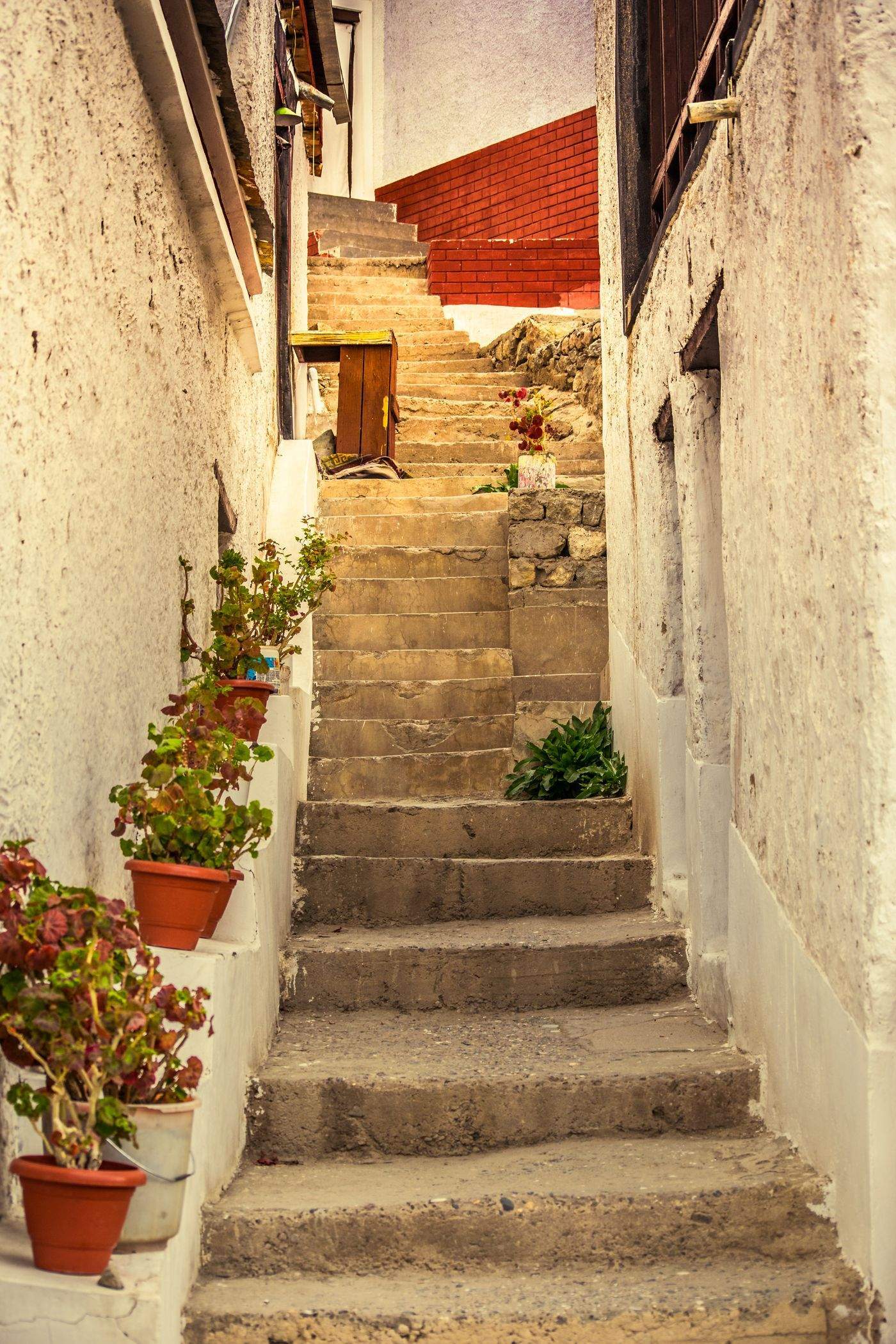
A pool is a pool is a pool, right?
Actually, not so much.
When you’re planning such a big investment, you need to look into the three primary pool types—concrete, vinyl liner, and fiberglass—to understand the differences.
River Pools specializes in fiberglass pools, but we know you need all the information on all the pool types in order to make an educated decision on what’s best for your needs.
For some people, concrete is the way to go.
Whether you’re looking up this information for the first time or simply need a refresher, here are some of the basics on concrete pools:
- Components
- Cost
- Pros and cons
- Construction process
Let's start by explaining what a concrete pool is in more detail.
What is a concrete pool?
Cement is actually a component of concrete, not the same thing, even though we tend to use the words interchangeably. Concrete is a mix of water, cement, sand, and a coarse aggregate (stone or gravel).
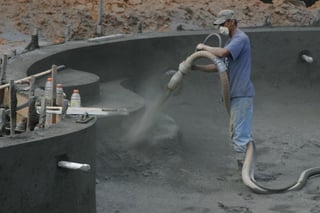
A concrete pool shell is created by spraying either gunite or shotcrete. Gunite is a dry mix with water in the sprayer, whereas shotcrete is already wet. These two methods produce the same result and have no significant difference in quality if done correctly.
After the concrete is sprayed on, it needs time to reach its full potential. It doesn’t dry, per se. It hardens and strengthens in a long process called curing. For a pool shell, this takes about 28 days.
The strength of concrete is measured by psi, the pounds per square inch necessary to crush it. An average concrete strength is 3500-4000 psi. It’s controlled by how many sacks of cement are added to the mix—the more cement, the stronger the concrete. The aggregate (the rocks or gravel mixed in) has a very high compressive strength: it takes a lot of pressure to crush concrete.
However, concrete has a very low tensile strength (against a force that pulls it apart), so when you try to bend or flex it, the force pulls on the surface and cracks it. On concrete pools, this can cause surface or structural cracks. Not ideal. Pool builders compensate for that by framing the concrete in a web of steel. The steel and concrete together create a solid structure that can bend and flex to withstand forces of water, earth, and gravity.
What is the average cost of a concrete pool?
A concrete pool can cost 85,000-200,000 depending on the region, but it’s not uncommon for them to cost more, especially with additional landscaping and accessories.
Maintenance across the life of the pool usually adds $20,000 or more on top of this initial cost. These details make up the initial and lifetime cost of ownership for a concrete pool.
What are the pros and cons of owning a concrete pool?
The pros and cons boil down to this: concrete has significant advantages in terms of appearance. However, maintaining that appearance takes a lot of time, money, and personal effort.
Concrete Pool Advantages
- Customizable
- Durable
- Pretty
Customizable
The primary advantage of concrete is that it’s highly customizable. Concrete pools give you the ability to customize the size, shape, or any other features you may be looking for. It could be in the shape of a car if you want; that would be super expensive but potentially doable. I wouldn’t recommend it, though.
Durable
Concrete pools are also very durable, like fiberglass is. You don’t have to fear that sharp objects will damage the pool structure, which is a weakness of vinyl liners. If you want to let your dogs swim in the pool, their nails won’t hurt the concrete.
As a side note, the plaster of the pool (the interior finish) is not as durable as the concrete structure itself and requires refinishing, which makes up part of the lifetime cost.
Pretty
Concrete also looks good. Maybe “pretty” isn’t the first adjective that comes to mind, but concrete provides a classic pool appearance. You don’t have to worry about a liner bubbling or separating, and if you keep up with the concrete pool maintenance, you can avoid the worst of staining and algae.
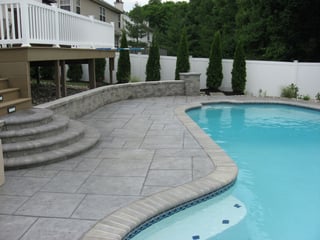
Concrete Pool Disadvantages
- Long startup process
- Rough surface
- High maintenance
- Significant time and money
- Frequent refinishing
Long startup process
The startup process for a concrete pool is long and drawn-out. Remember, the curing process alone takes almost a month, and a lot more goes into the construction process than just that. In contrast to fiberglass and vinyl liner pools, which can be completed in several weeks, concrete pools require 3-6 months to install.
Rough surface
The interior of a concrete pool is durable, but it’s also rough and can scrape your skin, especially for kids. There’s not much you can do about that texture, even with refinishing the plaster regularly.
High maintenance
The lifetime cost (follow-up costs and maintenance) is higher for concrete pools than for vinyl liner or fiberglass pools.
Concrete pools require a lot of hands-on maintenance. The porous nature of concrete means it easily harbors algae. Once embedded into the surface of a concrete pool, algae is extremely tough to remove. In fact, concrete pool builders recommend brushing the entire surface of the pool with a steel brush at least once a week to remove any algae that is on the surface.
Since most of this routine maintenance doesn’t merit professional work, your own effort will go into this upkeep. On the other hand, hiring a professional pool cleaning service will save you effort but not expense.
Significant time and money
Water chemistry is another issue with concrete pools.
Because the algae embeds into the surface, you have to use more chemicals to reach and destroy it. Also, concrete is alkaline-based, which constantly increases the pH of the pool water. You must test the water and add acid regularly to the water to keep it in balance.
This requires more time and money to maintain the pool.
Frequent refinishing
Because concrete is incompatible with salt, the dissolved salt in the pool water will shorten the life expectancy of the interior finish of a concrete pool. Because of this, you’ll need to refinish the plaster every 10-15 years, and you do need to hire professionals for this job.
In the long term, concrete pools cost much more money to own than fiberglass or vinyl liner pools. The initial price is compounded by follow-up maintenance and expenses such as acid washing by professionals every 3-5 years, more money in chemicals, more money spent on electricity, and refinishing/remodeling.
How are concrete pools made?
It generally takes 3-6 months to install and start up a concrete pool. If you’d like to learn more, you can read this more detailed outline of the construction process for concrete pools.
1. Concrete Pool Excavation
The builders excavate the earth and either haul it off-site or use it on the property.
This can take several hours to two days.
2. Steel Placement
The builders tie together a cage of steel bars, called rebar, and eventually encase it in the concrete shell.
This creates a web of strength and helps prevent structural failure. Remember that adding steel to concrete structures, such as swimming pools, increases the structure's ability to flex and move with its environment.
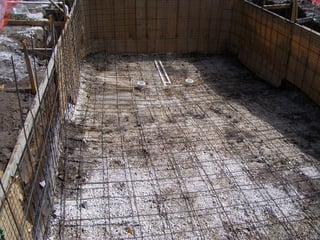
This stage takes 1-2 days.
3. Concrete Pool Plumbing
Before placing the concrete shell, the builders install the pipe needed to circulate the pool water. They installed much of this plumbing before the steel phase; however, some plumbing is supported by the steel and therefore installed after.
The builders should cap and pressure test this plumbing during the placement of the concrete shell. Typically, a plumbing and steel inspection is required at this point before the placement of the concrete pool shell.
This will take 1-2 days.
4. Concrete Shell Placement
The builders shoot concrete (either gunite or shotcrete) into place with a nozzle, then shape it using straight edges and flat, round-edged trowels.
In 1-2 days, you’ll be able to see the pool take shape.
5. 28-Day Cure Time
Curing is the process in which specific molecules within cement become hydrated with water. The more hydrated or cured concrete is, the stronger it becomes.
It takes concrete 28 days to achieve a relatively full cure.
6. Waterproofing
The builders may waterproof the pool shell. They smooth any rough areas of the shell, thoroughly clean the surface, and spray or roll on the waterproofing material.
This takes 1-3 days.
7. Tile and Coping
Because the surface of a concrete pool is porous and will stain at the waterline, it requires tile along the top 6 inches of the pool.
Coping is the concrete or stone border placed around the perimeter of the pool and provides the transition from the pool to the patio. Both tile and coping are typically done in conjunction by the same team or contractor and take from 3 days to 2 weeks.
8. Patio Installation
The builders prepare the base beneath the patio area by placing and compacting stone, and they install the patio over the course of 1-2 weeks.
9. Plaster
In the final construction phase, the builders apply the interior surface of the concrete pool. This is typically plaster, which is a mixture of cement, sand, marble dust, pigment, and water. The builders pump it through a hose, shoot it onto the pool shell, and trowel it to a flat finish.
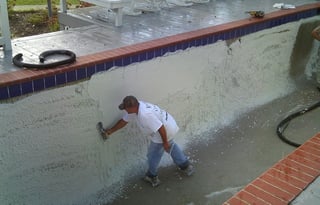
Usually the builders will complete this in 1 day.
10. Concrete Pool Start-Up
The builders—or, more often, you—check and balance the water chemistry daily. You must also brush the pool twice per day for at least the first 10 days after filling to remove plaster dust from the surface. You should not start up pool heaters until you’ve removed all plaster dust. You shouldn’t introduce chlorine for at least 48 hours.
The pool start-up will take 10 days.
What other options do I have?
Knowing the components, cost, pros and cons, and construction process for a concrete pool will help start you on the right path for your situation—but this isn’t everything you need to know to make your decision.
To ensure you’re getting the best value and the best fit for your home, you can compare the pros and cons of fiberglass, vinyl liner, and concrete pools here. For example, you’ll see that fiberglass pools dodge the disadvantages and achieve most of the advantages of concrete pools.
You can also download our free ebook which explores these comparisons in depth by clicking the button below.
View our full catalog of pool models here, and visit our gallery to see what we can do for your inground pool project. We have swimming pools of all shapes and sizes and for small to large backyards.
Want to know how much a fiberglass pool might cost? Contact us today to request pricing and discuss the specifics of your project, and in the meantime, try out our fiberglass pool pricing calculator for a fast estimate:

Want to see about how much that cost will be with all your favorite pool accessories?
Use our Design and Price Tool to walk through your options and approximate price!
As always, if you have questions or comments, please leave them in the comments below.
Up Next:
A Massive Review of Concrete Swimming Pools: Costs, Maintenance, Longevity, and More
10 Common Concrete Pool Problems and How to Avoid Them
Fiberglass Pool Basics: Pros, Cons, and How They’re Made
Editor's note: This article was originally written by Holly Jender and was updated on November 13, 2024, with current information. River Pools is a brand of inground fiberglass pools produced in a manufacturing facility in Fortville, IN. While our expertise is in manufacturing fiberglass pools, we have access to a network of installers with expertise relating to project design, installation, and pool service. We often tap into this knowledge base and share information freely with homeowners, just like you, considering installing a swimming pool in your backyard.
Topics:


